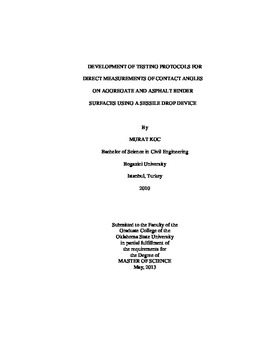| dc.contributor.advisor | Bulut, Rifat | |
| dc.contributor.author | Koc, Murat | |
| dc.date.accessioned | 2014-09-24T14:18:06Z | |
| dc.date.available | 2014-09-24T14:18:06Z | |
| dc.date.issued | 2013-05-01 | |
| dc.identifier.uri | https://hdl.handle.net/11244/11099 | |
| dc.description.abstract | Over the last several decades, the contact angle measurements have attained an increased popularity in several industries such as mining, petroleum, painting, coating, medicine, and recently in asphalt pavement materials. Contact angle measurement is a fundamental approach to determine the interfacial interaction that exists between a solid and a liquid, and between two different solids. In other words, one can calculate the surface free energy components of a solid material by using contact angle measurements.Surface energy interactions between the asphalt binder and aggregate are known as the fundamental approaches to predicting the mechanisms in the moisture damage process in asphalt mixes. The moisture damage is simply known as the loss of bonding strength between asphalt binder and aggregate, and as well as within the binder itself in the presence of moisture. Therefore, it is important to know the surface energy parameters of these materials for realistic characterization of the moisture damage process in asphalt mixtures. The field of surface energy measurement and its application for moisture damage evaluation is very recent and in the developing stages. Wilhelmy Plate (WP) method and Universal Sorption Device (USD) are the two most widely used techniques for surface free energy measurements. The former is being used for asphalt binder and the latter is equipped for aggregates.This thesis introduces a Sessile Drop (SD) device and new testing protocols for measuring the contact angles directly on asphalt binder and aggregate surfaces. Seven different aggregates and one asphalt binder from Oklahoma have been tested using the Sessile Drop method and the surface energy components of each material have been calculated using the Good-van Oss-Chaudhury (GVOC) approach and the measured contact angles. The calculated surface energy parameters have been compared with the same surface energy components of similar materials found in the literature. The comparison has indicated that both SD and WP methods have yielded similar results on asphalt binder specimens. However, the results from SD and USD methods on similar aggregate specimens are not in agreement and there are some significant differences. | |
| dc.format | application/pdf | |
| dc.language | en_US | |
| dc.publisher | Oklahoma State University | |
| dc.rights | Copyright is held by the author who has granted the Oklahoma State University Library the non-exclusive right to share this material in its institutional repository. Contact Digital Library Services at lib-dls@okstate.edu or 405-744-9161 for the permission policy on the use, reproduction or distribution of this material. | |
| dc.title | Development of Testing Protocols for Direct Measurements of Contact Angles on Aggregate and Asphalt Binder Surfaces Using a Sessile Drop Device | |
| dc.type | text | |
| dc.contributor.committeeMember | Cross, Stephen A. | |
| dc.contributor.committeeMember | Wilber, Gregory G. | |
| osu.filename | Koc_okstate_0664M_12646.pdf | |
| osu.accesstype | Open Access | |
| dc.description.department | Civil & Environmental Engineering | |
| dc.type.genre | Thesis | |
